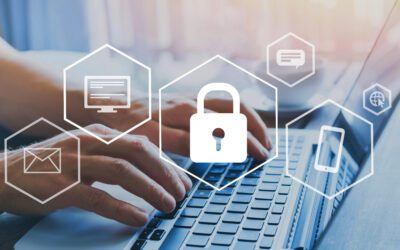While more students than ever will be heading back to their physical classrooms this year, the challenges of online learning won’t be going away anytime soon. Computers are now at the center of most classroom teaching plans, onsite or off. Do you know how to keep your child safe from hackers, online bullies, and data loss while they’re on their computers or mobile devices?
Integris knows that this year, back-to-school is like Christmas for the bad guys, and we are concerned for the online safety of students and their parents. Not only are the students themselves at risk, but your child’s use of unprotected devices along with a lax security approach may give the bad guys the window of opportunity they need to slide in and infect parents’ devices as well.
Online Safety Tips for Parents and Kids
Here are a few safety tips for online learning to keep your child and your network protected.
1. Keep Personal Information Personal
Warn your kids that school won’t ask for any personal information online via email or social media channel. Teach your children to come to you with any requests they receive for personal information so you can verify its authenticity. Remind your child never to respond to any popup windows requesting information.
Online learning safety pro tips: Online tools such as Google’s safesearchkids.com keep your child’s searches and browsing safe.
2. Keep Your Child’s Device Software Up to Date
Make sure your child’s device is updated and patched, using only the newest versions of the software they are using. Remember, just because a device is new doesn’t mean its software is updated. Enable automatic updates on all machines and devices so you never miss a patch.
Online learning safety pro tips: Review all privacy settings when updating an app. Installing or upgrading may change these settings.
3. You’re Never too Young for Multi-Factor Authentication
You can enable multi-factor authentication (MFA) in your child’s device to add an extra layer of security.
Online learning safety pro tips: It’s a good idea to upgrade all devices in the house, regardless of their use, to MFA.
4. Warning: That Attachment Isn’t What It Seems to Be
Warn your child never to open an unexpected attachment in social media or email, even during class. Teachers will alert the class of any attachments necessary for assignments.
Online learning safety pro tips: Just as with requests for personal information, remind your child to come to you with any unexpected links so you can verify their authenticity.
5. Malware and Anti-Virus on All Devices
Make sure to install a reliable anti-virus on all devices to protect them. Remind your child to update the anti-virus whenever alerted to do so.
Online learning safety pro tips: It’s important to have a rigorous anti-virus even if the device is issued by the school.
6. Strong Password Requirements for Kids
Remind your child not to use the same password across multiple applications, and to make passwords that are easily remembered but not easily guessed.
Online learning safety pro tips: If your kids don’t have a password manager, this is the perfect time to get them one.
7. Beware the Online Hoax
Kids are passing memes and videos around like hot potatoes. They also pass around unbelievable stories or ads that they find online, tagging each other to “check this out!” Online hoaxes are designed to raise a reader’s curiosity, offer solutions to common problems that are “too good to be true,” or pass malicious files around. These false news stories and fake ads are created to part a reader from their money, spread slander, or infect devices with malware.
Online learning safety pro tips: Remind your kids that if a story is “too good to be true” or “too shocking to believe,” chances are it’s a hoax.
8. Enjoy that Coffee…but Not that Wi-Fi
Kids using their devices in places with open Wi-Fi is never a good idea, even if “it’s just schoolwork.” They should never access any personal information while connected over an unsecured Wi-Fi connection, and should take care even when using social media in these locations.
Online learning safety pro tips:Check with your cellular carrier to enable the mobile hotspot (a portable password secured Wi-Fi application), on your child’s phone for use when outside the house.
9. Zoombombing is Still a Thing
Remember some months back when Zoombombing was a big deal? Luckily, businesses made common sense changes to the way they conducted meetings and Zoombombings aren’t as frequent, but teachers are keeping a careful eye out for the “next wave” of Zoombombings.
Online learning safety pro tips: Remind kids never to post any links to their classes on social media. These links provided the opportunity for Zoombombers to gain access to online classes.
Back-to-School Safety: A Special Note About Cyberbullying
Today’s digital world seems like a wonderful impossibility. Sharing information and communicating at the speed of light seems like a dream come true and for the most part, it truly is.
Cyberbullying, however, is a nightmare faced by far too many students. Any child can be bullied online for any reason regardless of age or gender. You may notice some unusual behavior in a child who is being cyberbullied. Some of these may include:
- Beginning to avoid activities or social situations they used to enjoy
- Becoming depressed or withdrawn
- Exhibiting a severe reluctance to log in to devices, even for school
- Shutting down social media accounts
- Hiding their screen or being reluctant to discuss online interactions
If your child is being bullied online, there are a few steps you can take to help them:
- Discuss, don’t ignore: Listen to your child. Never try to downplay the incidents, and always assure them that their feelings are valid. You must be supportive of your child, or s/he will be reluctant to share future incidences of cyberbullying.
- Help your child block the bully: Remove the bully from all your child’s media channels and tell them to delete messages from the bully without reading them. Remind your child never to engage the bully.
- Screenshots and Notifications: Keep screenshots of the conversation to show authorities, and don’t hesitate to alert authorities if the messages are threatening. Alert the school’s teachers, principals, and guidance counselors that your child is being targeted, but be sure you and your child are on the same page about these alerts.
- Support: This step is so important it needs to be repeated. Encourage your child to discuss the incidents. Listen calmly and understand that cyberbullying, while not something most parents have ever had to deal with themselves, is devastating to the child.
Some helpful online organizations and resources for your child include:
- https://www.wiredsafety.com/
- https://www.stopbullying.gov/resources/get-help-now
- https://www.pacer.org/bullying/resources/cyberbullying/
- https://kidshealth.org/en/teens/cyberbullying.html
Stay alert to your child’s online interactions, and don’t be afraid to ask the hard questions. The earlier you can spot cyberbullying and intervene, the easier it will be for your child to overcome it.
Safety Tips for Online Learning: That’s a Wrap
The most important take-away is that your child’s device will be a temptation for bad actors. While hackers aren’t interested in Algebra or social studies, they will use unprotected devices to infect your network and gain access to your personal information or, if you work from home, your work’s network.
Don’t hesitate to reach out to your school district and ask what back-to-school safety tips for online learning they have implemented for the school year.
Integris wishes your children a safe, productive, and happy school year.
Related: 7 Back to School Tech Tips and Gadgets for your student



